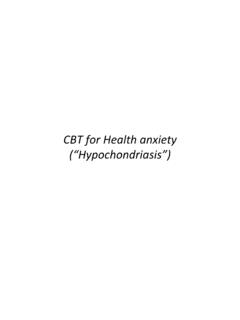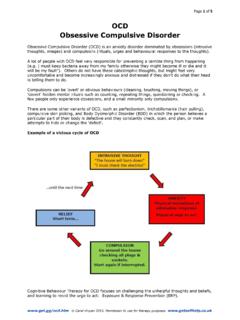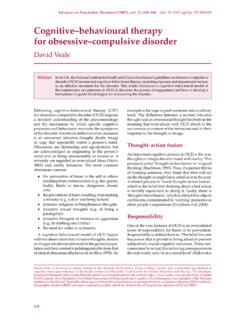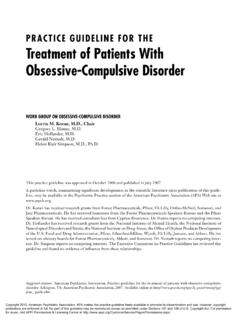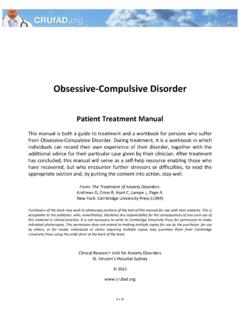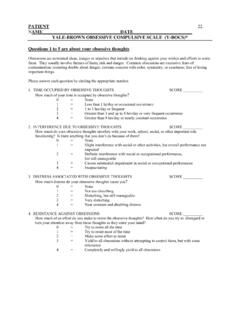Transcription of CBT Treatment Obsessive Compulsive Disorder
1 CBT TreatmentObsessive Compulsive Disorder1 OCD DEFINITION AND DIAGNOSIS NORMAL WORRIES & COMPULSIONS DYSFUNCTIONAL/ABNORMAL OBSESSIONS DSM IV DIAGNOSIS2 OCD DIAGNOSISDSM IV & ICD 10A significant source of distress and/or interferenceOBSESSIONSR ecurrent, persistent thoughts, images or Impulses experienced, at some point, as intrusive and senselessAttempts to ignore and/or suppress and/or of ownership of thoughts, yet perceived as ego dystonic; content unrelated to another Axis 1 DIAGNOSISCOMPULSIONSR epetitive, purposeful and intentional behaviourPerformed in response to an obsession or according to certain rulesDesigned to neutralise or prevent discomfort and/or of their unrealistic and/or excessive : DIFFERENTIAL DIAGNOSISMAJOR DEPRESSIVE DISORDERGENERALIZED ANXIETY DISORDERHYPOCHONDRIASISSPECIFIC ILLNESS PHOBIAANXIETY DUE TO A GENERAL MEDICAL CONDITIONAPPETITIVE DISORDERSBODY DYSMORPHIC DISORDERDELUSIONAL DISORDER5 OCD DIFFERENTIAL DIAGNOSISOBSESSIVE Compulsive PERSONALITY DISORDERABSENCE OF OBSESSIONS AND/OR COMPULSIONSPERVASIVE PATTERN OF.
2 ORDERLINESS PERFECTIONISM CONTROL ONSET BY EARLY ADULTHOOD6 BEHAVIOURAL MODEL OF ANXIETY BEHAVIOURAL Treatment INVOLVES EXPOSURE TO FEARED STIMULI/SITUATIONS (CS) WITHOUT THE MALADAPTIVE RESPONSE TO PERMIT THE EXTINCTION OF THE CONDITIONED RESPONSE (CR)ADVANTAGES EXPLICIT PREDICTIONS DEMONSTRABLE PLAUSIBLE PRACTICAL/DIRECT TREATMENTDISADVANTAGES PREPAREDNESS INDIVIDUAL DIFFERENCES DEVELOPMENTAL INFLUENCES LACK OF TRAUMATIC ONSET SOCIAL & SYMBOLIC ACQUISITION OFANXIETY7 OCD Treatment APPROACHESBEHAVIOUR THERAPYR ationale & Behavioural Assessment se e Figure 1 Exposure and Response PreventionMaintenance and GeneralizabilityRelapse Prevention8 Typical Steps in the Behavioural Assessment of OCDS pecify the rituals and obsessions in detailWhat situations evoke the rituals or obsessions ( , do the rituals occur only at home)?Are there any fluctuations in the symptoms ( are they worse if the patient is alone)?
3 What situations does the patient avoid as a result of OCD?9 Fig. 1 Typical Steps in the Behavioural Assessment of OCD (Contd.)Do any thoughts, images, or impulses trigger (eg sacrilegious images, aggressive impulses) rituals or obsessions ? Construct hierarchy of target situations based on the amount of anxiety (SUDS scale), ritualising, or obsessing they does the patient believe will occur if he or she does ritualise? How strong is this belief?Are the patient s symptoms being maintained by family interactions?Is the patient severely depressed? If so, consider trial of 1 Typical OCD Fear HierarchyOCD: Client Exposure GuidelinesERP Session by Session Habituation14 Stimuli and situations(Internal or external)Including external triggers,intrusive thoughts and informationCOGNITIONDANGER, THREATS afety seekingBehaviours (includingAvoidance, escape, and neutralising)Biological and Psychophysiologicalreactions15 CBT Model of OCD from Salkovskis (1985)Potential StimuliIntrusion Ego DystonicAutomatic Thoughts Ego syntonicMood Disturbance, discomfort, dysphoria, anxietyNeutralising ResponseEscape BehaviourRewarding Non-punishmentPerception of ResponsibilityIncreased AcceptanceAvoidanceTriggering Stimuli(Internal/External)Extrinsic Mood DisturbanceSchematic Activation.
4 Accessibility of loss, threat or blame ideation ExpectancyReduced DiscomfortA COGNITIVE THEORY OF OBSESSIONSOBSESSION DESCRIPTION INTERPRETATION DISTRESS/ CONSEQUENCESFEART hought :Sinful : Revealing about me I will cause harm Intense resistanceImage Disgusting Warning signs People will reject me to obsessionsImpulse Alarming Losing control I will be locked up Attempts to block them Going insane NeutralisationsI am dangerous Avoidance BehaviourA postulated sequence of descriptions, interpretations and actions (from Rachman)16 Cognitive Obsessions and Covert RitualsIntrusive ThoughtNegative AppraisalIncreased Anxiety and WorryOvercontrolVigilance (Could I really do it?) Covert Rituals TestingTemporary Anxiety ReductionCycle starts all over again17 EXAMPLE OF THOUGHT/ACTION FUSION AND OC METACOGNITION I m having a bad thought that must mean I m bad.
5 I wouldn t be having these thoughts if I wasn t truly bad! The more bad thoughts I have, the more proof I have that I m bad. Because I m thinking so much about doing bad things, it must mean that I m highly likely to do something bad. If I don t try hard to prevent harm from happening, it is as bad as doing something bad on purpose. Since it is likely that I m going to do something bad, I d better watch out for it. I may even have to make sure that others are protected from my bad actions. 1820 OCD: COGNITIVE Treatment APPROACHES Psychoeducation of CBT Model of OCD Shared Formulation Identification of Intrusions & Appraisals Cognitive Restructuring of Appraisals & Beliefs Role of Compulsions, Neutralization & Avoidance: ERP Behavioural Experiments Modifying Metacognitive BeliefsOCD: Examples of Behavioural ExperimentsOCD: Relapse PreventionSusan: OCD Case Formulation External Triggers bathrooms, dirty pupils, marking schoolwork, sharp objects, bathing the baby Intrusive Obsessional Thoughts - Ideas: I am contaminated - Doubts: I might assign the wrong mark - Images: Stabbing and drowning baby Catastrophic Interpretations of Obsessions - I will get ill & make my family ill - I can t take the chance this will happen - The more I think it the more likely it is.
6 - I can & should control my thoughts or I am fully responsible for the outcome - These thoughts mean that I m a terrible mother Obsessional Anxiety/Fear Safety-Seeking Behaviours - Avoidance: pupils, public toilets, baby - Rituals: washing, checking, mental health - Neutralising: concealment, suppression Dysfunctional Beliefs - Overestimates of the probability and severity of danger - Inflated sense of responsibility for danger - Certain thoughts should be controlled Lack of Correction of Beliefs Safety behaviours prevent correction of catastrophic beliefs Thought Suppression Leads to more unwanted thoughts Hypervigilance Increases preoccupation and salience of cues Negative Reinforcement Of safety behaviours by distress reduction Short-Term Anxiety/Fear Reduction Susan: An Exposure HierarchyOCD: Client Ratings 25 Obsessive Compulsive Inventory (OCI)26 Responsibility Interpretations Questionnaire (RIQ)27 The Responsibility Attitudes Questionnaire (RAS)2829 OCD for CBT: Some TipsUse Multi faceted AssessmentPsychoeducation & Motivational InterviewingWork to an AgendaStay focussed and calmHomework, homework, homework!
7 Recognise Roadblocks The perfect is the enemy of the good
